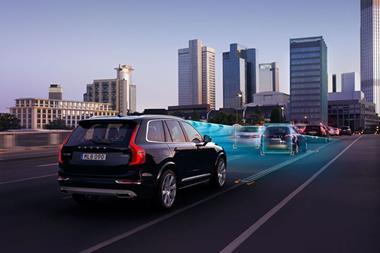Thatcham Research sets out ten key features and performance criteria to define autonomous vehicles
Thatcham Research has set out criteria to assess whether a vehicle is truly autonomous or not, in accordance with the Automated and Electric Vehicle Bill.
The Automated and Electric Vehicle Bill defines an automated vehicle as: “A vehicle that is designed or adapted to be capable, in at least some circumstances or situations, of safely driving itself, i.e. that it is operating in a mode in which it is not being controlled, and does not need to be monitored, by an individual”.
According to Thatcham’s criteria, if a car requires any input from the driver while on the road then it cannot be classified as an autonomous vehicle. For example, if it is only able to function properly on certain stretches of road and must have driver control on others, then it is assisted rather than autonomous.
Essentially, if it is unable to navigate certain situations and requires driver control in any scenario, then it cannot be autonomous.
“The insurance industry welcomes the UK Government’s commitment in the Automated and Electric Vehicles Bill to create a list of automated vehicles. It is crucial, therefore, that that there is a clear definition of what constitutes an automated vehicle,” Thatcham Research director of research Matthew Avery commented.
Insurers welcomed the move towards clarity in what has been an area of some confusion.
Avery explained: “These descriptors will shine a light into the potentially dangerous grey area semi-automated vehicles could create. It is also important to shift the focus onto the safe performance of a vehicle’s automated system. We will therefore assess new vehicles against these criteria to determine if a car is assisted or automated and to drive standards in automated performance. This will require a constant dialogue with carmakers as the technology develops.”
ABI senior policy adviser for motor and liability Ben Howarth added: “Truly automated vehicles have the potential to drastically reduce road accidents, cut delays and make it easier for people who cannot drive to get around. However, there will inevitably be a transition period from today’s cars to the vehicles of the future, via vehicles which offer gradually increasing levels of autonomy.”
“There is the potential for confusion during this interim stage when people could wrongly think their vehicles can be left alone to manage a journey independently. Insurers want to see manufacturers being absolutely clear about how they describe what their vehicles can do – and we think this checklist of ten things which define a truly automated vehicle should be adopted across the industry to help give clarity to consumers,” Howarth continued.
The development of autonomous vehicles continues to raise questions for insurers. The Autonomous and Electric Vehicles Bill tackled the issue of customer contact, putting the onus on the insurer rather than the manufacturer to look after a claimant.
Data, however, is still a bone of contention, with insurers needing to know whether a claimant was driving a car was on autopilot at the point of a crash.
They have urged for a record of data on automated functionality to be available for all individual vehicles, via their Vehicle Identification Number. This would log when vehicles are running on old software, or need maintenance. This would be vital information in the event of a claim and the information would need to be updated in real time.
Avery explained, “By recording these changes at Vehicle Identification Number level, insurers, rental and lease companies, fleet operators as well as law enforcement agencies would be made aware of any change to the automation status of a vehicle. Immediate data access will also be essential in allowing insurers to determine whether the driver or automated system was at fault in the case of an accident.”
Thatcham’s 10 key features and performance criteria required of a truly automated vehicle:
- Naming: clearly describes automated capability
- Law abiding: complies with UK traffic laws and the Highway Code
- Location specific: functionality is limited to specific types of roads or areas via geo-fencing
- Clear handover: transfer of driving control follows a clear ‘offer and confirm’ process
- Safe driving: vehicle can manage all reasonably expected situations by itself
- Unanticipated handover: adequate and appropriate notice must be given if the vehicle needs to unexpectedly hand back driving control
- Safe stop: vehicle executes an appropriate ‘safe stop’ if unable to continue or the driver does not take back control
- Emergency intervention: vehicles can avoid or prevent an accident by responding to an emergency
- Back-up systems: safeguards step in if any systems fail
- Accident data: record and report what systems were in use at the time of an accident
A fully functioning level 4 autonomous vehicle, which would conform to Thatcham’s criteria, is not likely to exist until at least 2021.
Hosted by comedian and actor Tom Allen, 34 Gold, 23 Silver and 22 Bronze awards were handed out across an amazing 34 categories recognising brilliance and innovation right across the breadth of UK general insurance.













































No comments yet